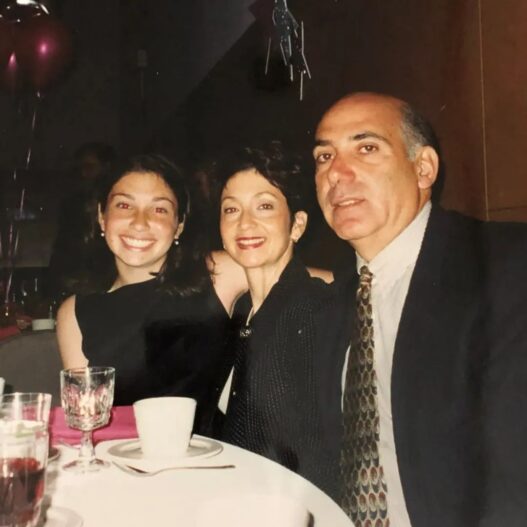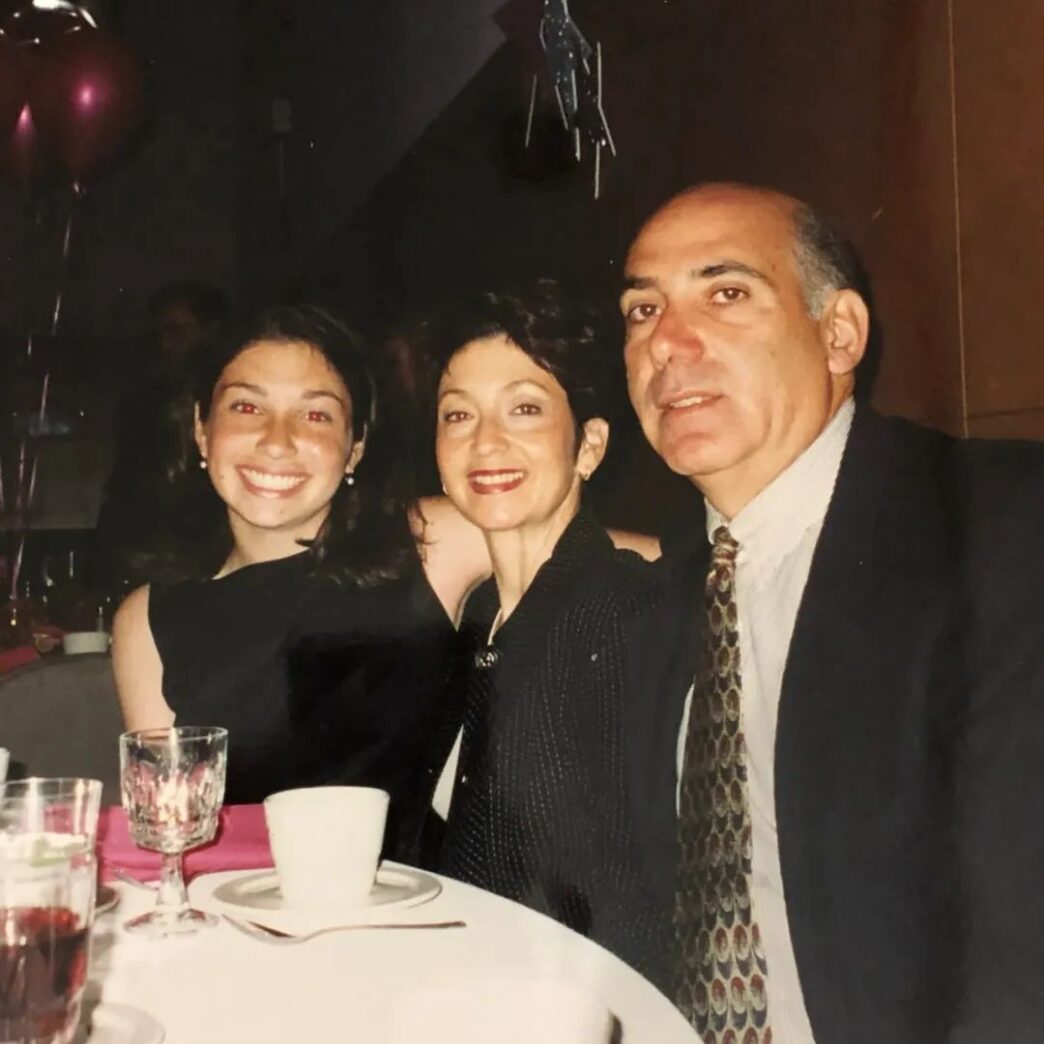Victim had 20 Stab Wounds, 10 in the Back—Police Conclude: Suicide…
This might sound like an outlandish plot from a crime novel, but it’s a real case that occurred in the United States.
The incident took place in January 2011, when Erin Greenberg was found dead in the apartment she shared with her fiancé at the age of 27.

(Erin)
Erin’s death was gruesome. She had 11 bruises:
- One on her abdomen
- Three above her right knee
- Three on her right thigh
- A large, dark bruise below her right shoulder
- Three on her right forearm
These bruises were at different stages of healing, indicating they were inflicted over several weeks before her death.
But the knife wounds were even more horrific. The medical examiner counted 20 stab wounds:
- One pierced her chest muscle, going through her liver
- One severed her aorta, causing massive blood loss
- One penetrated the dura mater, directly damaging her spine
Her chest and abdomen had 10 knife wounds, her neck and back of the head another 10. The knife that killed her was still lodged in her heart.

(The murder weapon)
The day after Erin’s death, the medical examiner, Osborne, concluded: “Erin was stabbed to death; this is a homicide.” However, he soon changed his conclusion at the suggestion of the police investigators to something that baffled Erin’s parents, friends, and countless online commentators: They said Erin had committed suicide.
# Reasons for the Suicide Ruling
Authorities provided their reasons for concluding that Erin’s death was a suicide:
- Erin’s apartment was in a quiet neighborhood with good security. The only ways into her home were either through the balcony, which was impossible due to a heavy snowfall that day leaving no footprints, or through the front door.

(Erin’s apartment building)
- Could the murderer have entered through the front door? No, according to the police report received by Osborne, Erin’s body was discovered when her fiancé and apartment staff broke down the door, which was locked from the inside.
From the police’s perspective:
- Erin was alone in the apartment, the door was locked from the inside, and there were no signs of forced entry or strange items left behind, leading to the conclusion of suicide. After all, reality isn’t a detective novel filled with locked-room mysteries.

(Erin’s apartment door)
- Additionally, the police received information that Erin’s mental state was very poor.
They stated:
Erin was under a lot of work pressure and was reluctant to appear in photos. She wanted to move but wouldn’t explain why. She had seen a psychiatrist, who diagnosed her with adjustment disorder and anxiety. Her mother, who visited her, also felt Erin was hiding something.
On the morning of her death, Erin made a final phone call to her father, saying “I love you” in what seemed like a farewell.
Doesn’t this prove she took her own life?
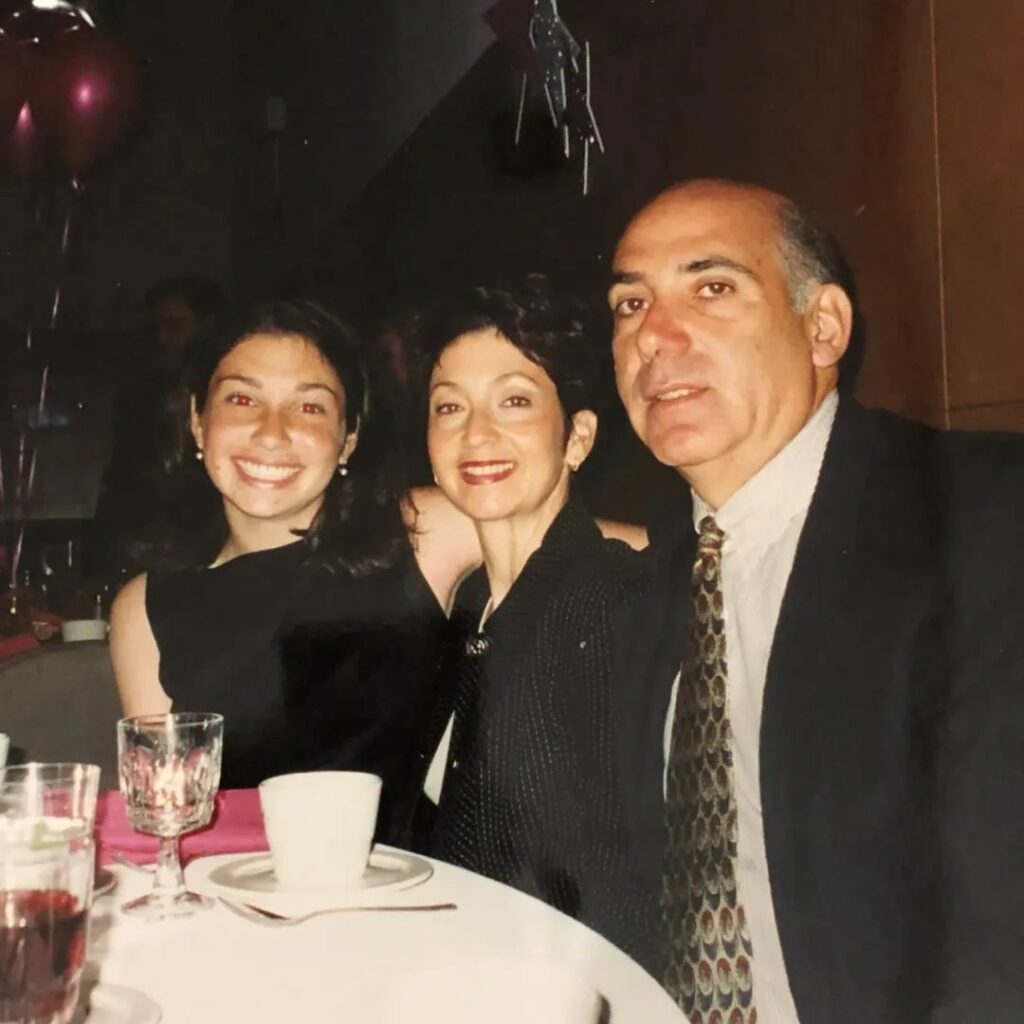
(Erin with her parents)
But what about the bloodstains, the wounds, and the bruises?
The police argued:
- Reality is often stranger than the detective stories we read. They once found a man dead from blunt force trauma, surrounded by blood, initially believed to be a murder. However, surveillance footage showed he simply fell, injured himself, and died… just like that, just that odd.
Perhaps Erin’s case was similar; she committed suicide, but the process went awry, leading to the bizarre crime scene… Case closed.

(Reflection of Erin’s apartment building in the nearby lake)
In 2011, authorities made their ruling. But Erin’s parents never believed she committed suicide. They decided to fight for the truth, seeking justice for their daughter.
Over the next 13 years, the elderly couple spent over $700,000, hiring forensic pathologists to analyze crime scene photos and skeletal remains, engaging another crime scene expert, and collaborating with a retired police investigator to find potential witnesses.
They filed two lawsuits:
- One to challenge the suicide ruling
- Another accusing local law enforcement of covering up a murder, implicating the local police department, medical examiner’s office, district attorney’s office, and even the state’s Attorney General at the time, Josh Shapiro.

(Former Pennsylvania Attorney General Josh Shapiro)
Their persistence paid off. In 2023, a lower court found significant flaws in the official investigation of Erin’s death. Just a few months ago, the Eastern District Supreme Court of Pennsylvania approved their appeal, ordering a re-examination of Erin’s death.
As the couple presented their collected evidence, it became clear that there was indeed more to this case than initially thought.
# The Intriguing Case
Erin’s parents brought in an expert named Wayne Ross, a forensic pathologist who had performed over 13,000 autopsies. He questioned the original medical examiner’s findings:
Ten years ago, the medical examiner claimed Erin had no defensive wounds, suggesting suicide. However, Wayne pointed out that if Erin was unconscious before being stabbed, she couldn’t have defended herself, explaining the absence of defensive wounds.
How did she lose consciousness? Wayne indicated a bruise on Erin’s neck, suggesting she was strangled into unconsciousness.
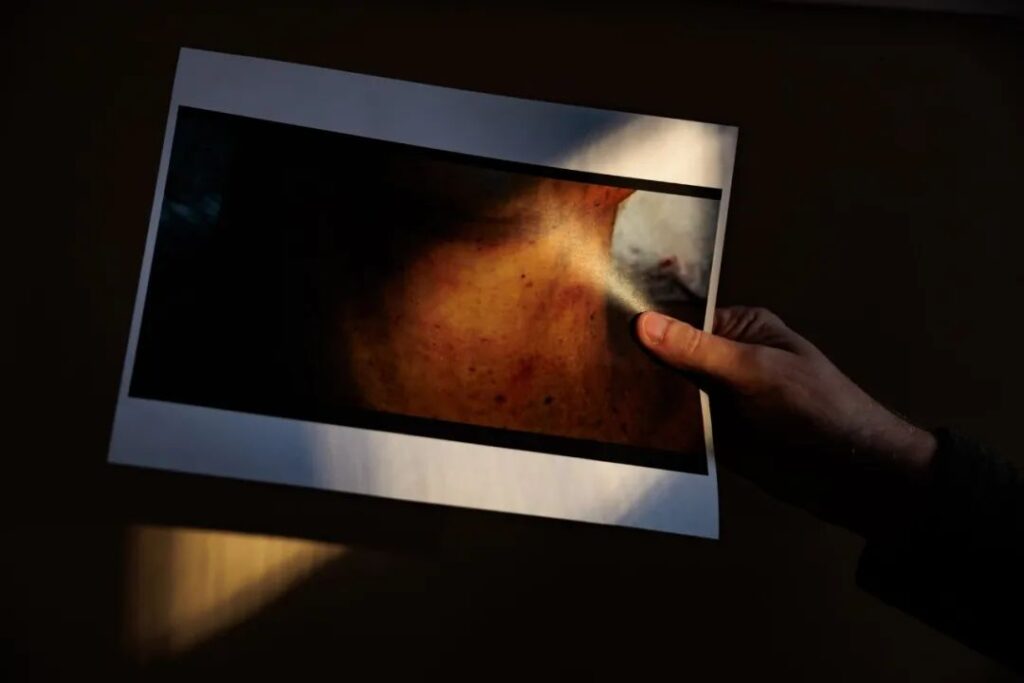
(Bruise on Erin’s neck)
- This bruise was not mentioned in the initial autopsy report. Osborne, the original medical examiner, explained that since he found no signs of hyoid bone fracture or bleeding in the eyes/face, he concluded Erin was not strangled.
Another point of contention was the strange crime scene:
- Police photos showed Erin sitting on the kitchen floor, leaning against a cabinet, holding a clean white towel in her left hand.
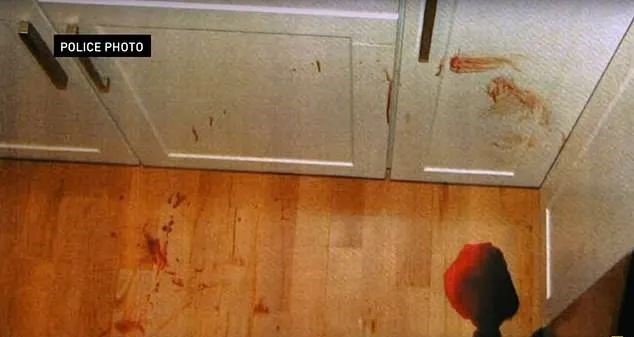
(Crime scene photo)
Wayne found the crime scene photos peculiar. There was a dry bloodstain running horizontally from Erin’s nose to her ear, which was inconsistent with her sitting position. Such a bloodstain would only occur if she had been lying flat for an extended period.
Another oddity was the clean towel in her left hand, despite a pool of blood near her left hand.
Additionally, photos showed Erin’s hair scattered on the floor.
Wayne explained, “See the hair? When someone is strangled or stabbed, the assailant often grabs the hair like this.”
A company created a 3D model of Erin’s stab wounds, showing how difficult it would be for her to inflict so many wounds on herself:
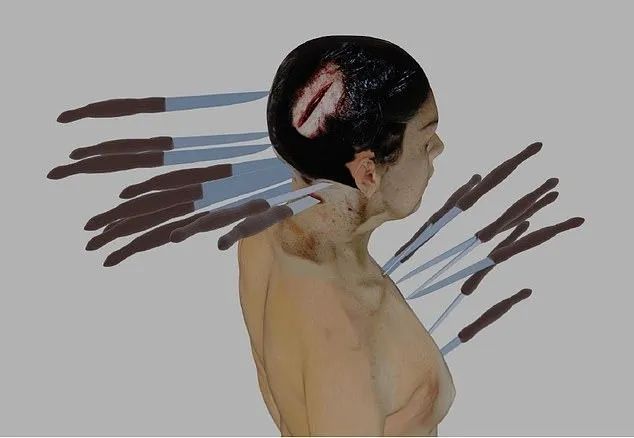
(3D model of Erin’s stab wounds)
They had a female police officer of similar build to Erin attempt to replicate the suicide scenario, but she couldn’t do it.
Especially considering Erin’s left hand was clean, suggesting she used only her right hand to inflict 20 wounds. Is this even possible?
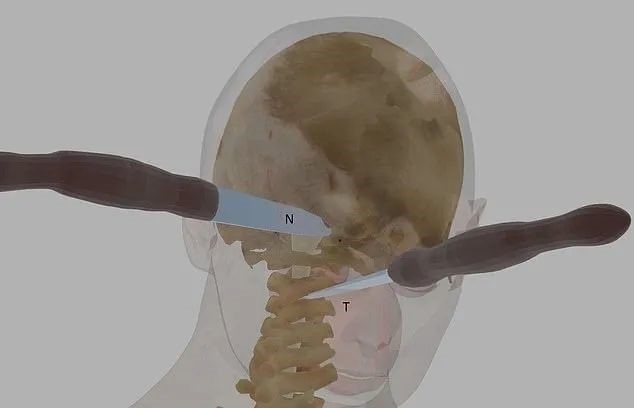
(Two stab wounds on the back of Erin’s neck, an awkward position if self-inflicted with only the right hand)
But didn’t the police say no one else entered the room? How did the perpetrator leave?
This brings us to another issue—the police investigation was flawed!
Earlier, it was mentioned that the medical examiner received information that a security guard accompanied Erin’s fiancé upstairs. However, this guard later submitted an affidavit stating he did not accompany the fiancé.
If Osborne wasn’t lying, it means the police provided him with false information to support the suicide narrative.
Additionally, neighbors did hear Erin’s fiancé knocking, but the property manager explained that the doors in the building often locked themselves due to loose latches when slammed shut, and she herself had accidentally locked herself out this way.

(Apartment door)
Erin’s parents and friends all maintain she would never commit suicide. She was aware of her mental health issues but was actively seeking change, planning to quit her job and move back with her parents, who were willing to take her in.
Police claimed they found searches for “painless suicide methods” on Erin’s computer, but a secondary FBI investigation found no such searches.
This raised more questions: Where did Erin’s “painless suicide” search records go? And even if she did want a painless death, why choose to stab herself 20 times?

(Photo of Erin in life)
Subsequent media interviews with nine of Erin’s close friends and family revealed no one believed the suicide story, except for one person—her fiancé, Sam Goldberg, the first to find her body.
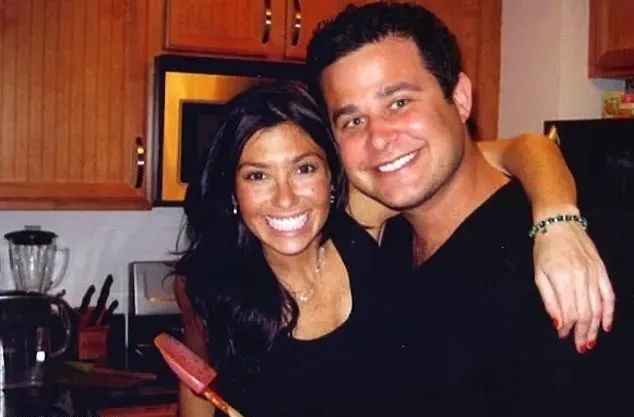
(Erin and Sam’s photo)
Sam, the discoverer of the body, would typically be the prime suspect, but he was never charged.
Initially, Erin’s friends thought Sam was a nice guy, from a wealthy family, chubby and seemingly harmless, often compared to a teddy bear. But they later realized he was not simple.
Sam and Erin were engaged and planning a wedding for August 2011. However, friends noticed Erin didn’t love Sam; she was scared of him. As the wedding approached, Erin became increasingly submissive to Sam. She had to consult him on plans, and in life, she followed him like a loyal dog, losing her once confident and independent demeanor.
The bruises on Erin’s body seemed to be the result of prolonged domestic abuse. When asked about abuse by the psychiatrist, Erin denied any verbal or physical conflict, only praising Sam.

(Erin, Sam, and friends)
On the day of Erin’s death, Sam’s behavior was also peculiar. His text messages before discovering her body read:
- “Hello”
- “Open the door”
- “What are you doing?”
- “I’m getting angry”
- “You better have an excuse”
- “What the hell are you doing?”
- “You’re in trouble”
Thirty minutes later, Sam called 911, claiming he had just entered the apartment and found his fiancée dead, surrounded by blood.
Sam seemed very flustered, repeating “no” four times when the dispatcher asked if Erin’s chest was still moving. Yet, there was a knife protruding from Erin’s back through her chest, which Sam didn’t mention.
Two minutes later, when told to perform CPR, Sam seemed to realize the knife was there.

(Erin and Sam’s photo)
Investigators now questioning Sam wonder why he showed no fear during the 911 call. Given Erin’s condition, it was clearly a murder, yet Sam never considered someone might have killed her or that the murderer could still be in the apartment: “Even if you don’t think of it first, you’d think of it eventually, right? Did you search the apartment? Are you sure you’re safe?”
Surprisingly, the police investigating the case at the time didn’t ask these questions. Sam was released without any interrogation or investigation.
Three years later, Sam married into wealth with a real estate heiress.

(Sam’s wedding)
Over the past decade, Erin’s parents have uncovered more and more questions, each unanswered query weighing heavily on their hearts.
Now, 13 years later, the court has finally approved the elderly couple’s appeal, reopening the investigation. We don’t know what the final outcome will be, but we hope the truth of that day will be revealed, and justice will be served for Erin.







